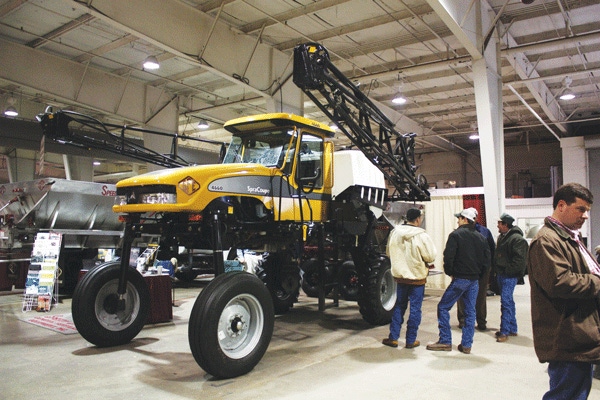March 18, 2011

Healthy prices for corn, wheat, cotton and soybeans, combined with the promise of additional contracts for tobacco, contributed to a brisk sales season for agricultural machinery as southern farm shows progressed through the winter.
A recent farm show in Raleigh, N.C., enjoyed three of the strongest days in its history in terms of farmer interest.
“Most of our exhibitors said they did really well, especially those who had the bigger equipment on the floor,” said Southern Farm Show Manager David Zimmerman. “Farmers seemed to come in prepared to spend money.”
Ben Coston of GFE of Greensboro, N.C., said he was pleased with the traffic at the show. “It was steady all three days,” he said.
GFE’s most popular product was the Speedy Spread, a stainless steel all-hydraulic truck spreader. “We build that ourselves,” Coston said. “We took some orders for it at the show.”
There was also considerable interest in the Spra-Coupe sprayers GFE had on display. “A lot of that was because of the increase in cotton acreage,” he said.
Several farmers took a moment to speak to Southeast Farm Press:
• Charles Jones of Cherryville, N.C., took a hard look at a ‘V’rake at the BEFCO exhibit. It isa pull-type rake that BEFCO says is easy to transport on roads and is easy to store. Its single-action, push-up hydraulic system allows the rakes to float when in operation. “It cuts down on your time in the field,” said Jones. “We could use it.”
• Jones’ friend Chris Lewis of Gastonia, N.C., was very interested in some of the precision agriculture machinery he saw. He told Southeast Farm Press that some add-ons to planter equipment had really caught his attention and may find their way onto his operation soon.
• Ben Ketchie of Cleveland, N.C., got a demonstration of Case IH North America’s new Selective Catalytic Reduction (SCR) technology for reducing emissions. In its literature, Case describes SCR, which is based on a special Diesel Exhaust Fluid, as “the best answer for farmers to be ready for government-mandated emissions standards now and in the future.”
“This show has been real good for us,” said Ronnie Holland of Clinton (N.C.) Trucks and Tractor, who helped man the Case exhibit. “I think it is one of the better shows on the East Coast. There were some ‘tire kickers,’ of course. But many farmers were looking at specific pieces of machinery, and some were considering purchases down the road a bit.”
There probably would have been even more sales onsite, but a lot of purchases had been made at the end of 2010, he said.
The opportunity to increase acreage of either cotton, corn, soybeans or tobacco will make for some tough decisions for farmers in North Carolina in coming weeks.
Viable alternatives for tobacco
Strong commodity prices for corn, soybeans and cotton make them viable alternatives for tobacco, said Blake Brown, North Carolina Extension economist, at the annual meeting of the Tobacco Growers Association of North Carolina, which was held in conjunction with the Southern Farm Show.
“At this time, 2011 crop cotton could be booked for around $1 per pound in North Carolina,” said Brown. “While some cotton-producing areas have limited gin capacity for expansion, North Carolina actually has much unused gin capacity, placing Tar Heel farmers in good position to increase cotton production.”
But they could just as well increase tobacco production. Which one offers the best profit potential? Here is how Brown calculates it:
• The five-year average yield for North Carolina cotton is 844 pounds per acre. If farmers book cotton at $1 per pound, then potential revenue per acre could be projected at $844. Operating costs per acre are around $525, and land rent is around $100. “This leaves a potential $244 per acre return to equipment and management for growing an acre of cotton,” said Brown.
• Using the five-year average yield for tobacco of 2,226 pounds per acre and an estimated price of $1.75 per pound gives an expected revenue from an acre of tobacco of about $3,895. “Using an estimate of operating costs per acre of $2,750 and land rent of $100 gives a return to management and equipment of flue-cured of $1,045 per acre,” he said.
That would mean it would take 43 acres of cotton to yield an equivalent return to management and equipment as 10 acres of tobacco.
The question for North Carolina growers who have equipment to grow extra tobacco or cotton will be, “Would I rather grow an extra 43 acres of cotton or an extra 10 acres of tobacco?” said Brown.
But there is a complicating factor relating to tobacco. A new company — United States Growers Direct — says it wants to contract for 100 million pounds of flue-cured from the 2011 crop.
Could American growers produce that much additional flue-cured? It would be a tall order, said Brown.
“Suppose demand at current prices from traditional buyers is up 30 million pounds for 2011,” he said. “Production of 490 million pounds would be needed to satisfy demand (just) from traditional buyers.”
Even if enough acreage was planted to get that much volume produced, is there enough barn capacity to cure it? “Unless there is evidence that the 2011 increase in demand is permanent, it is unlikely new equipment will be manufactured or purchased to increase current capacity,” said Brown.
You May Also Like




